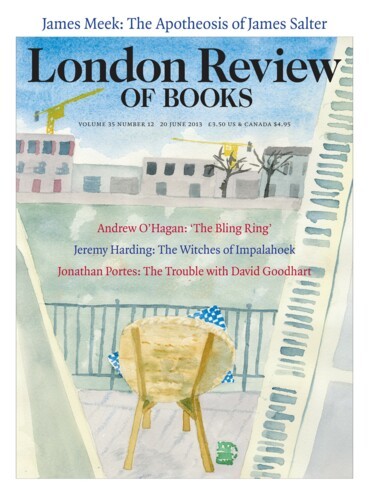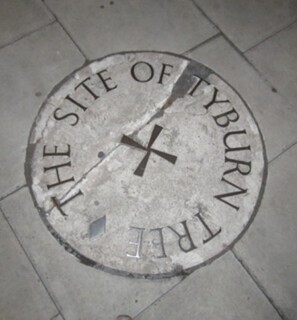At midnight on the eve of a hanging day or ‘hanging fair’, usually a Monday, the bellman of St Sepulchre-without-Newgate recited these verses to the men and women due to be executed:
All you that in the condemn’d Holds do lie,
Prepare you, for to Morrow you shall die.
The next morning, between nine and ten, a procession left the prison, to the sound of church bells, first those of St Sepulchre, then of other churches along the route. The condemned, whose irons were struck off in the prison’s press yard in the presence of their friends and relations, climbed into a horse-drawn cart that took them on the three-mile journey to the gallows.
The route to Tyburn Tree snaked through Holborn and St Giles, then went along Tyburn Road, today’s Oxford Street. It was dense with spectators. At Tyburn itself, a hundred thousand people might be in attendance, jostling one another for standing room, teetering on ladders, sitting along the wall that enclosed Hyde Park – all competing for a glimpse of the moment when the condemned man or woman ‘danced the Paddington frisk’. ‘The whole vagabond population of London,’ the diarist Francis Place wrote, ‘all the thieves, and all the prostitutes, all those who were evil-minded, and some, a comparatively few, curious people made up the mob on those brutalising occasions.’
The memorial to the execution site at Marble Arch is embedded in the pavement on one of the traffic islands at the junction of Bayswater Road and the Edgware Road. The victims of the gallows might number as many as fifty or sixty thousand. The 17th and 18th-century poor, in the days when Britain constituted what Peter Linebaugh has called a thanatocracy, are uncommemorated, as are the apprentices, the economic migrants and the vagrants who were hanged for trifling crimes against property. Even the infamous victims remain unnamed. There is no mention of Jack Sheppard, the most charismatic and popular thief of the time, who twice escaped from Newgate, and whose execution in 1724 drew a crowd of two hundred thousand people. Nor is there any testament to Oliver Cromwell, whose remains, along with those of two other regicides, were disinterred after the Restoration, and hanged at Tyburn in a posthumous execution.
The Tyburn Tree plaque seems even more modest when compared with the elephantine public sculptures that have been deposited at Cumberland Gate. In a poem written for a BBC documentary in 1968, John Betjeman described the site as a place of martyrdom ‘trodden by unheeding feet’. The ‘greatest crime’ of all, he continued, standing on the roof of Marble Arch and speaking in the voice of a genteel, if irritable prophet, is ‘the martyrdom of London’:
Behold the harvest Mammon yields
Of speed and greed and worry.
Marble Arch was originally designed by John Nash in the 1820s as a triumphal entrance for Buckingham Palace, then relocated to Hyde Park, where Thomas Cubitt rebuilt it in 1851. But – because Nash’s original plans for reliefs commemorating English victories in the Napoleonic conflict were never fully executed – the triumph it celebrates is an oddly blank one. After it was ‘islanded’ in 1908, Chesterton remarked that ‘in its new insular position, with traffic turning dizzily all about it’, the Marble Arch was a ‘massive symbol of the modern mind’: ‘a door with no house to it; the gigantic gate of Nowhere’.
From 1851, the upper chambers of the arch were used as a police observation post, with room for a hundred officers, all ‘ready to rush out’ in the event of a civil disturbance. During the demonstration against the Sunday Trading Bill in 1855 – which Karl Marx excitedly identified as the beginning of the English Revolution– a detachment of police leaped out from between the legs of the arch and ambushed the protesters. During the Reform League’s demonstrations for universal male suffrage in 1866, it was once again the scene of skirmishes with police on horseback. I was at the riot in 1994 against the Criminal Justice Bill, a raft of measures that persecuted Gypsies, ravers, travellers and young people already susceptible to discriminatory stop-and-search procedures; and again mounted police repeatedly charged at demonstrators from the precincts of the arch.
One night last June I set out with a companion to retrace the final journey of Tyburn’s victims, but in reverse. About three hours after we started towards Newgate, police called to Marble Arch found a man in his mid-forties lying dead on the central concourse. He was Mark Morrison, a Scot who had once worked as a chef but had for some time been homeless. He had been strangled with a strip of green tent fabric. A week later, an Afghan asylum-seeker in his mid-twenties, Ghodratollah Barani, was charged with Morrison’s murder. Psychiatrists at both St Thomas’s and the Gordon Hospitals had examined Barani before the murder, because he had repeatedly tried to gain entry to Buckingham Palace, claiming voices had told him that, in order to become the rightful King of England, he needed to kill someone; but he had been discharged. Police officers at the palace had assumed it was a ruse to secure asylum. In March this year, Barani pleaded guilty to manslaughter on the grounds of diminished responsibility. He was detained under the Mental Health Act and recommended for deportation on his release.
Send Letters To:
The Editor
London Review of Books,
28 Little Russell Street
London, WC1A 2HN
letters@lrb.co.uk
Please include name, address, and a telephone number.


